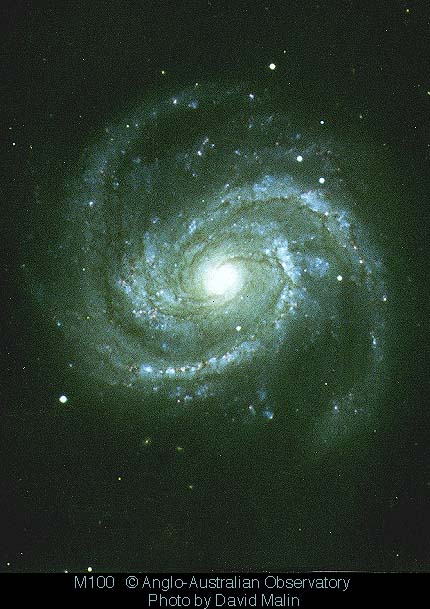In addition to studying
the motions of stars, we can use observations of other types of objects
to help determine the structure of the galaxy. For example, the distribution
of gas and dust may be different from the distribution for stars.
Recall that the hyperfine
splitting (electron spin-flip) of the hydrogen ground state can be studied
at the characteristic wavelength of photons emitted--21 cm in the radio
part of the spectrum. This emission is very optically
thin, but there are so many H I atoms
(neutral hydrogen) that the emission line can be seen everywhere in the
galaxy--there is very little obscuration. This is a prime method
for delineating spiral structure in our galaxy. If we know the rotation
curve for the galaxy and assume that the gas is in circular orbit around
the galactic center, we can use 21-cm line profiles to map the spiral arms.
Here is how it works:
Along a given line of sight, say there are four clouds A, B, C, and D.
Each is in its own orbit around the galaxy, and so has a different radial
velocity, so what would be a single line is split into several components
as shown above. Note that the highest velocity peak is the one that
lies closest to the center of the galaxy along that line of sight, which
is the distance Rmin.
From different lines of sight, we build up maps of spiral arms. Note
that the spiral structure is poorly determined towards l = 0, 180
(why?).
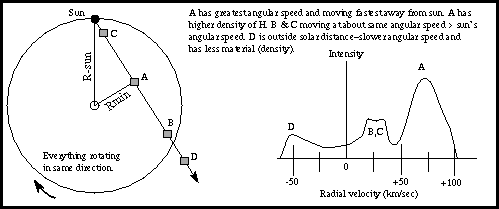
A has the greatest
angular speed and is moving fastest away from the Sun. A has
higher density of hydrogen, so appears with the highest intensity. B
and C are moving at about the same angular speed, greater than the
Sun's angular speed. D is outside the solar distance, so has
slower angular speed, and also has the lowest hydrogen density. (This
image is from Nick Strobel's web
site.)
We already saw that the distribution
of H I is different from molecular clouds (e.g. CO). Note that CO
is a proxy for H2
(molecular hydrogen), meaning that these two constituents are found together
and so are distributed in the same way. From measurements of CO we
find that the inner galaxy is mostly H2
while the outer galaxy (R > 8.5 kpc) is mostly atomic H.
From our studies
of the motions of stars, gas clouds, and other objects, we can develop
the rotation curve for the galaxy.
Below are measurements of the rotation curve from CO, H I, and H II regions.
Why do you think the measurements get so uncertain beyond about 8 kpc?
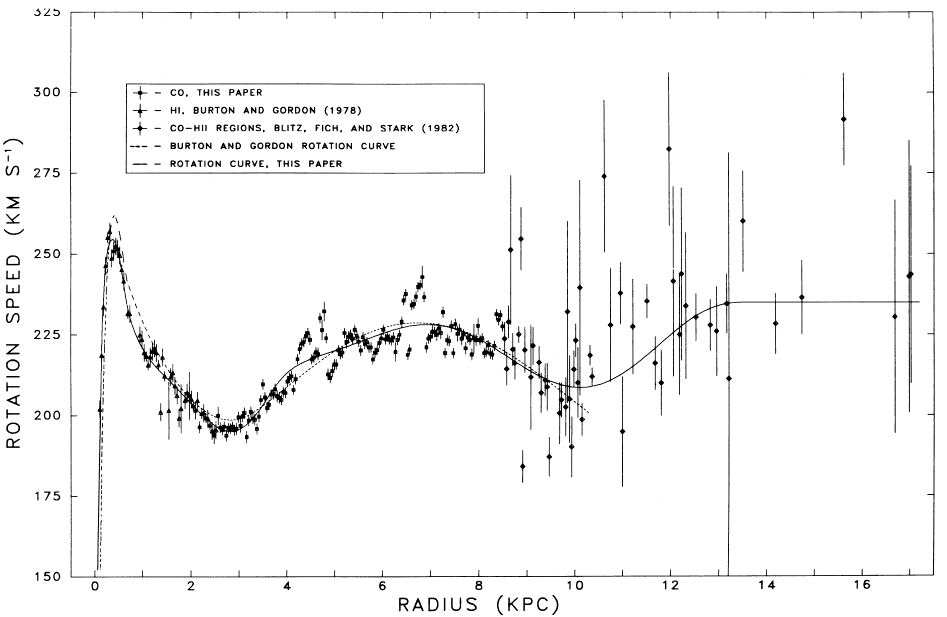
The rotation curve of the
Milky Way Galaxy. The IAU standard values of Ro
= 8.5 kpc and Qo
= 220 km/s have been assumed. (Figure reproduced from Clemens
(1985), Ap. J. 295, 422.)
The contributions to the
overall rotation curve are shown in the figure below. The top curve
at left shows the total rotation curve. It has contributions from
the spherical galactic bulge and the
disk,
but these contributions do not make up the entire curve, so another contribution
called the corona must exist.
The corona is not evident in anything we can see, so-called
luminous
matter, so it must be due to some form of dark
matter.
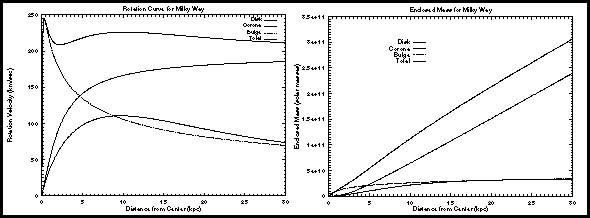
The plot on the left shows
the Total rotation curve for our galaxy, made up of contributions
from the Bulge, the Disk, and the Corona. The
plot on the right shows the Interior Mass, M(R), as a function
of radius (called the enclosed mass here). Both the disk and
the bulge reach a constant interior mass, meaning that at a radius of 25
kpc or so, all of the mass is inside this radius, and the rotation curve
for these components drops approximately as R-1/2.
The corona mass (dark matter), however, appears to continue to rise with
radius! (This image is from Nick Strobel's web
site.)
What
is this dark matter? We only know that it exists from its gravitational
influence, so some possibilities are:
-
gas (no, should
see absorption or emission lines of stars shining through it)
-
dust (no,
dust causes extinction of starlight, and glows in the IR)
-
MACHOs--Massive,
compact halo objects? (e.g. small, faint stars such as black
dwarfs [dead white dwarfs], brown dwarfs [failed stars], neutron stars,
or black holes)?
-
WIMPs--Weakly
interacting massive particles? (e.g. neutrinos, or some as-yet-undiscovered
particle)?
We can estimate how the density
of either MACHOs or WIMPs might fall off from the center of our galaxy.
Assume they exist in a spherical halo (not just in a disk shape).
To cause a constant rotational velocity vo,
say, we must have acceleration due to gravity equal to the required centripetal
acceleration
GM(r)/r2
= vo2/r
or
M(r) = rvo2/G.
(1)
So the interior mass must increase
proportional to r. The
mass of a thin spherical shell is
dM(r) = 4pr2r(r)
dr => dM(r)/dr = 4pr2r(r)
but taking the derivative of
(1) wrt r gives
dM(r)/dr = vo2/G,
so the density required for
constant rotational velocity is
r(r) = vo2/4pr2G.
This means that if the density
falls off by r-2,
the interior mass will grow with radius (because the volume increases by
r3),
and we would expect a constant rotational velocity with radius.
Note that galactic rotation
curves are even easier to measure in other galaxies, and they all show
this same tendency for a dark matter halo. We will see that the dark
matter problem only continues to get more extreme as we consider larger
scale structures of the universe.
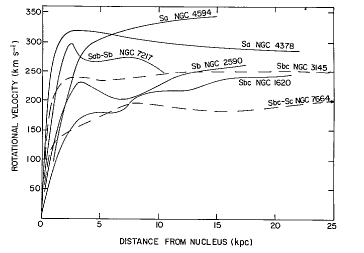
A series of rotation curves
for spiral galaxies. (Figure from Rubin, Ford, and Thonnard (1978),
Ap. J. Lett., 225, L107.)




